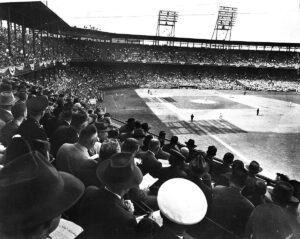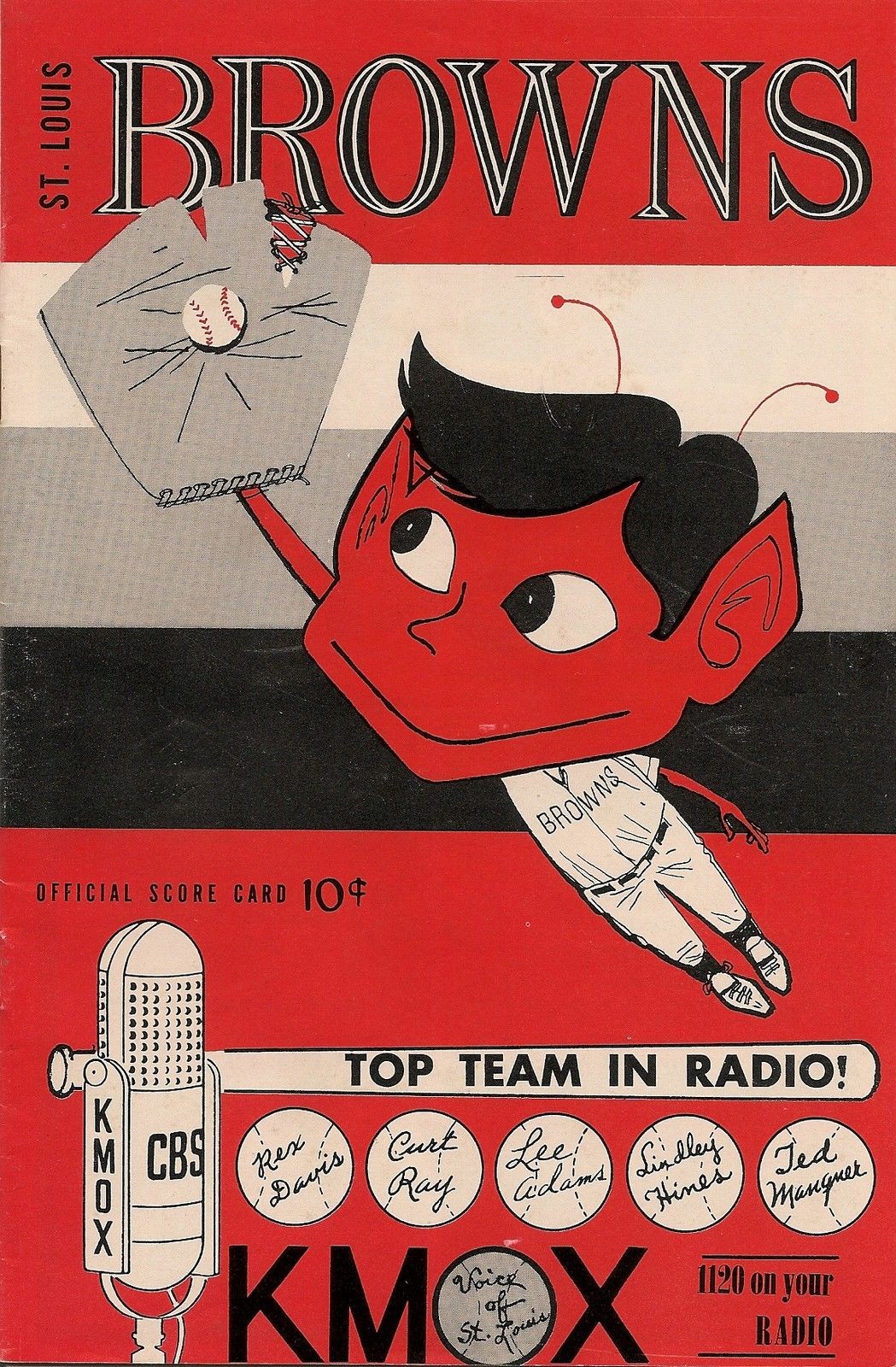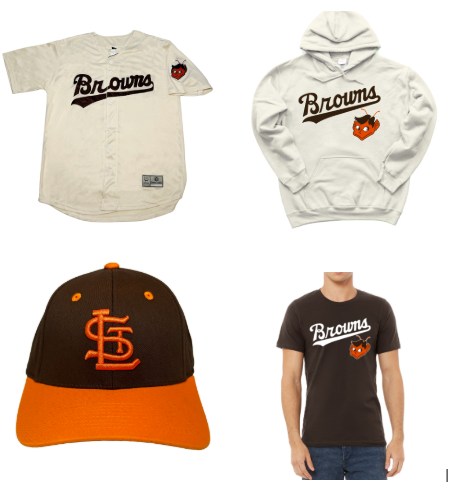Tombstone
Born: January 28, 1902 (Milwaukee Brewers transfer to St. Louis)1Baseball News, The Baltimore American, January 29, 1902
Moved: September 29, 19532Baltimore Gets St. Louis Browns, The Baltimore Afro-American, October 3, 1953
First Game: April 23, 1902 (W vs. Cleveland Blues 5-2)
Last Game: September 27, 1953 (L vs Chicago White Sox 2-1)
AL Pennant: 1944
Stadium
Ballpark:
Sportsman’s Park II (Busch Stadium I): 1902-1953
Opened: April 7, 1902
Closed: May 8, 1966
Demolished: 1967
Ownership
Owner(s):
- Robert Hedges (1902–1915)
- Philip De Catesby Ball (1916–1933)
- Ball estate (1933–1936)
- Donald Lee Barnes (1936–1945)
- Richard Muckerman (1945–1948)
- Bill DeWitt (1948–1950)
- Bill Veeck (1951–1953)
Marketing
Team Colors:
Dark brown, white (1902-1905)
Black & white (1906)
Black, white, dark brown (1907)
Dark brown, white (1908-1933)
Dark brown, orange, white (1934-1951)
Dark brown, white (1952-1953)
Attendance
Background
The St. Louis Browns baseball team was established in 1902 when the original Milwaukee Brewers relocated to Missouri. The move made St. Louis a two-team town for over half a century, and for most of that time, the city belonged to the Browns.
Our Favorite Gear
St. Louis Browns Apparel
When it comes to replica jerseys, we turn to our friends at Royal Retros, who put extraordinary detail into their fully customizable baseball jerseys, including those for the St. Louis Browns.
Free Customization Included
Each jersey individually handmade
Any name and number
Sewn tackle twill crest, numbers & letters
100% polyester
Heavyweight fabric made to game standards
Relive the days when St. Louis was a two-team town in great apparel from Royal Retros. Choose from jerseys, T-Shirts, hats, hoodies, and shorts, in multiple styles and colors.
In the beginning
The first pro baseball team in Mound City was the St. Louis Brown Stockings, who transformed from a highly successful barnstorming team into a charter member of the American Association (AA) in 1882. The following season, they became simply the Browns. That club won five straight AA pennants (1884-1888), before that league merged with the National League (NL) following the 1891 season. As a result, four AA clubs, including the Browns, joined the NL. Oddly, the Browns changed their nickname in 1900 to the Cardinals (after a year as the Perfectors) and are in business to this day.
In 1902, the American League (AL) emerged as the newest competitor to the established National League. The AL started in 1899 as a minor league circuit called the Western League. In 1900, it changed names before it declared major league status in 1902.
Following the AL’s first major league season, commissioner Ban Johnson got the notion that his circuit should compete directly with NL in the established league’s cities. At a league meeting held December 2-3, 1901 at the Grand Pacific Hotel in Chicago, he encouraged the owners of the Milwaukee Brewers, Henry and Matt Killilea, to sell their team to St. Louis interests.
Head to head
The deal was consummated on January 28, 19023Killilleas Give Up Stock of St. Louis Club, The Baltimore American, January 29, 1902, when a syndicate led by Ralph T. Orthwein took over the club and officially moved it to St. Louis. The team almost immediately revived the Browns name, while the former owners, the Killilea brothers, bought the Boston Americans (now Red Sox) less than a week later.
The Browns finished their first season in St. Louis with a record of 78 and 58, good for second place, while the crosstown Cardinals ended with 56 wins against 78 losses and a sixth-place finish. Unfortunately, the fans weren’t keen on the newcomers, and Orthwein quickly lost his enthusiasm.

In 1903, Robert Hedges, a member of the syndicate headed by Orthwein, assumed ownership of the team, along with John E. Bruce and Cal McDiarmid. The team stumbled for the next few seasons, dropping to sixth place in 1903 and 1904 before finishing dead last in 1905. While on-field play was sluggish, attendance steadily increased. In 1908, the Browns drew 618,947 fans, topped only by the 1922 season. Gate receipts were so good that Hedges netted a profit of $165,000, most of which he put back into the team, as well as the team’s home, Sportsman’s Park.
The ups and downs of baseball ownership
In 1913, Hedges made a shrewd move when he hired former Major League catcher Wesley Branch Rickey to help run the front office. The benefits weren’t immediately apparent as the Browns and Cardinals finished in last place, the only time both clubs ended up in the cellar in the same season.
The following season brought more headaches for both clubs with the emergence of the Federal League (FL). The FL had been a minor league in 1913, its first campaign, before declaring major league status in 1914. One member of the eight-team FL was the St. Louis Terriers.
The St. Louis FL entry finished in last place in 1914 and drew small crowds, but they were a fly in the ointment (to use an old-timey term) nonetheless. The FL sapped talent from the AL and NL and drove up salaries. By the end of the 1915 season, the established leagues’ owners, particularly Hedges, had had enough.
A truce is declared
A settlement was reached after the 1915 season that allowed several FL owners to buy into or purchase outright teams in the AL and NL. Hedges sold to former St. Louis Terriers owner Phil Ball in a deal worth $425,000, or $15.8 million in today’s dollars.
The 1916 Browns featured twelve former Terriers and finished in fifth place with a record of 79 and 75. The team muddled along for the rest of the decade, hampered, like the rest of Major League Baseball, by a loss of talent and resources due to World War I.
In 1920, St. Louis Cardinals owner Sam Breadon struck a deal with Ball that would allow the Cards to use the Browns’ stadium, Sportsman’s Park. Author Bill Borst wrote in his book Still Las in the American League: The St. Louis Browns Revisited that this move sowed the seeds of the Browns’ eventual departure from the city. After playing the first half of the 1920 season at tiny, rickety old Robinson Field, the Cards moved into the far nicer and more modern Sportsman’s Park on July 1 as tenants of the Browns.
In 1922, the steadily improving Browns found themselves in a heated pennant race with the New York Yankees. Several key moves by the Yankees in late July gave them just enough of an edge to finish a game ahead of the Browns.
Another ownership change
The Browns spent the rest of the 1920s in the middle of the AL pack. In 1933, Ball passed away, leaving the team in the hands of his estate, with Louis Von Weise as club president. In 1936, Von Weise asked Branch Rickey, who had moved onto the Cardinals front office a few years earlier, to find a buyer for the Browns. Rickey produced Douglas Barnes of Chicago, who bought the club for $325,000. The deal did not include Sportsman’s Park, though, as that remained in the hands of the Ball estate.
Barnes hired Bill DeWitt to run the front office and introduced the idea of small stock ownership. He sold shares in the Browns for $5 each. Many fans hung on to those shares long after the team moved. However, in 1981, Baltimore Orioles owner Edward Bennet Williams forced those shareholders to sell.
The team continued its mediocre ways through the end of the decade and into the 1940s. By 1941, Barnes had grown tired of trying to keep the team afloat and competitive. He also concluded St. Louis wasn’t big enough to support two major league teams. This view was shaped, in part, by the success in the late ‘30s and early ‘40s of the Browns’ stadiummates, the Cardinals.
Go West?
Barnes looked west and hoped to move the team to Los Angeles. His old buddy, Phillip K. Wrigley, owner of the Chicago Cubs, even agreed to give up his territorial rights to L.A. and move his Pacific Coast League (PCL) Los Angeles Angels to Long Beach. His fellow American League owners were also on board. Travel logistics were worked out, and Barnes had a tentative schedule drawn up. The announcement was going to be made on December 8, 1941. However, on the day before the big press conference, something really big outside of the world of sports happened.
While things looked bleak, particularly for the Browns, the team bounced back with a solid effort in 1942. They finished 82-69. Sadly, that put them 19 and a half games behind the pennant-winning Yankees, but it was cause for optimism among the St. Louis AL faithful.
A slight stumble in 1943 preceded the most successful team in Browns history, as the 1944 club finally clinched the AL pennant. Their opponents in the World Series were none other than the crosstown Cardinals, who won the championship in six games.
Stuck in the Muck
The following season, Richard Muckerman became the majority owner of the club. He had been a stockholder since 1939 and had gradually increased his holdings. However, he also ran into financial difficulties.
He bought Sportsman’s Park from the Ball estate. He then bought property in San Antonio and built a new ballpark for the Browns minor league team, the Missions. With expenses outpacing income, Muckerman left the door open for a move to L.A. When asked about the possibility of a relocation to California, he ominously said, “The fans of St. Louis will answer that question.
After a few years, Muckerman threw in the towel and sold the team to the DeWitt brothers, Bill and Charly, who had been working in the team’s front office. They had been promised a chance to bid on the team if Muckerman ever decided to sell, and on February 2, 1949, the DeWitts bought the Browns.4Brothers Purchase Browns, AP via The Nashua Telegraph, February 3, 1949
The Veeck years and the end
The DeWitts couldn’t turn things around either. With a million-dollar loan due in 1954, they opted to sell the club to Bill Veeck. The former Cleveland Indians owner, famous for his unusual promotions and publicity stunts, brought his bag of tricks to St. Louis.
Veeck also believed that St. Louis could only realistically support one team, but his solution was not to move the Browns. He instead wanted to drive the Cards out of business, or at least out of town. He almost succeeded but not by fielding a winning team.
Cardinals owner Fred Saigh had run into some tax problems and was forced to sell the team. A deal was nearly finalized that would have seen the team relocate to Houston, home of the Cards’ minor league ballclub. At the last minute, though, Anheuser-Busch stepped in and bought the club, putting the final nail in the Browns’ coffin.
Veeck first tried moving the team (back) to Milwaukee, but that town was home to the Boston Braves AAA affiliate, the Brewers. Veeck offered the Braves $700,000 for the rights to Milwaukee. Boston owner Lou Perini declined and instead moved the Braves there in March of 1953.
After that, Veeck got in contact with representatives from Baltimore who were actively seeking a team. Rumour swirled that the 1953 season would be the Browns’ last in St. Louis, and attendance plummeted. On Tuesday, September 30, 1953, two days after the last game of the season, the deal was finalized, and the St. Louis Browns became the Baltimore Orioles.
Our friends at the Good Seats Still Available podcast did an episode on the St. Louis Browns:
Additional source: Still Last in the American League: The St. Louis Browns Revisited by Bill Borst, Atwerger and Mandel Publishing Co., Inc., 1992. ISBN: 1-878005-53-7


